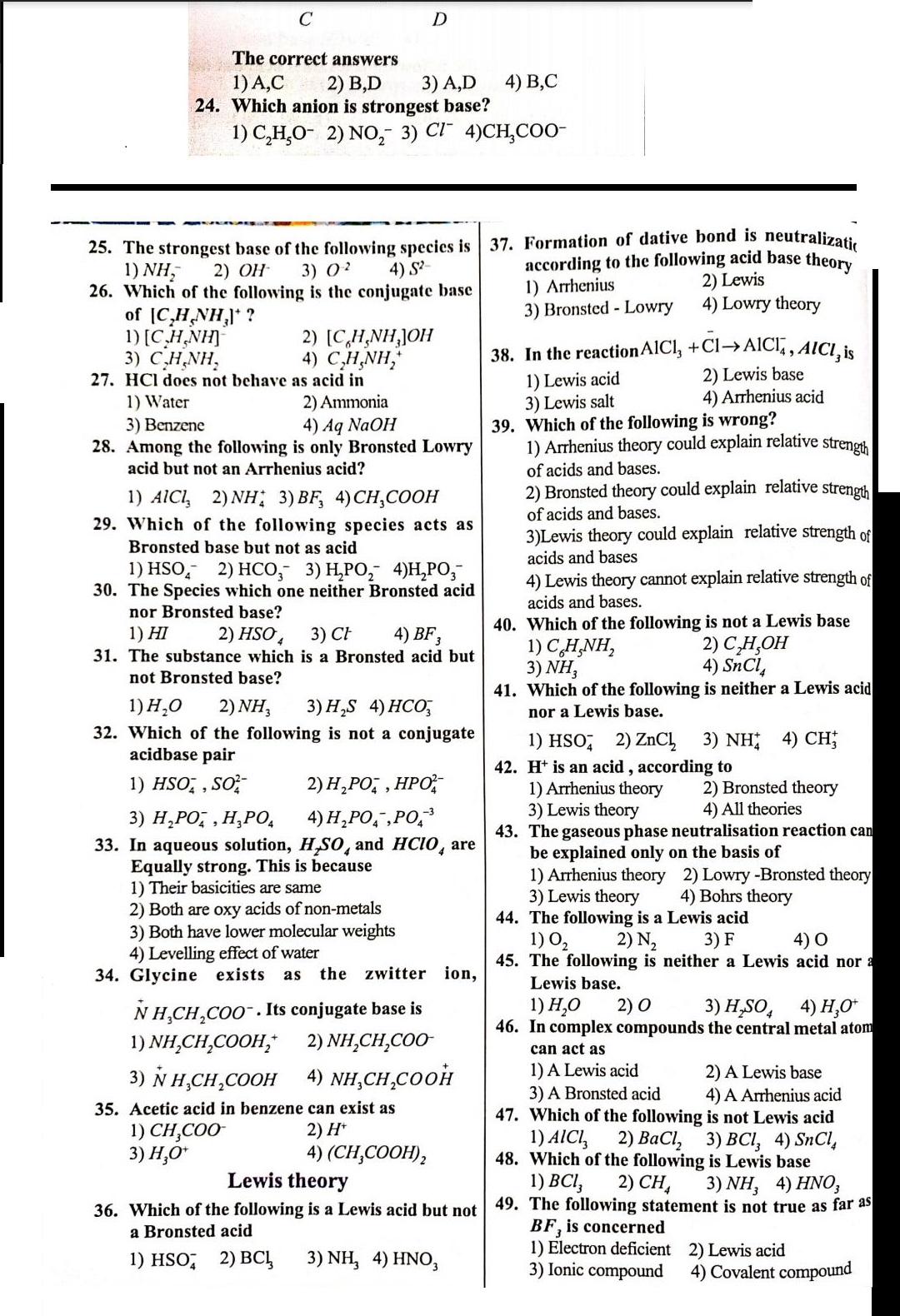Answered step by step
Verified Expert Solution
Question
1 Approved Answer
The correct answers 1) A,C 24. Which anion is strongest base? 1) C,H,0- 2) NO, 3) CI 4)CH,CO0- 2) B,D 3) A,D 4) ,

The correct answers 1) A,C 24. Which anion is strongest base? 1) C,H,0- 2) NO, 3) CI 4)CH,CO0- 2) B,D 3) A,D 4) , 25. The strongest base of the following species is 37. Formation of dative bond is neutralizati, 1) NH, according to the following acid base theory 1) Arrhenius 3) Bronsted - Lowry 4) S?- 26. Which of the following is the conjugate base 2) OH 3) 0? 2) Lewis 4) Lowry theory of IC,H,NH,* ? 1) [CH,NH] 3) C,H,NH, 27. HCI does not behave as acid in 2) [C,H,NH,JOH 4) C,H,NH," 38. In the reactionAICI, +CIAICI, AICI, is 2) Lewis base 4) Arrhenius acid 1) Lewis acid 3) Lewis salt 39. Which of the following is wrong? 1) Arrhenius theory could explain relative streneh of acids and bases. 2) Bronsted theory could explain relative strength of acids and bases. 3)Lewis theory could explain relative strength of acids and bases 1) Water 2) Ammonia 3) Benzene 4) Aq NaOH 28. Among the following is only Bronsted Lowry acid but not an Arrhenius acid? 1) AICI, 2) NH; 3) BF, 4)CH,COOH 29. Which of the following species acts as Bronsted base but not as acid 1) HSO, 2) HC, 3) ,, 4),, 30. The Species which one neither Bronsted acid nor Bronsted base? 4) Lewis theory cannot explain relative strength of acids and bases. 40. Which of the following is not a Lewis base 1) C,H,NH, 3) NH, 41. Which of the following is neither a Lewis acid nor a Lewis base. 4) BF, 2) HSO, 31. The substance which is a Bronsted acid but 1) HI 3) CH 2) C,H,OH 4) SnCl, not Bronsted base? 1) H,0 32. Which of the following is not a conjugate acidbase pair 2) NH, 3) H,S 4) HCO, 1) HSO, 2) ZNC 3) NH 4) CH; 42. H* is an acid, according to 1) Arrhenius theory 3) Lewis theory 43. The gaseous phase neutralisation reaction can be explained only on the basis of 1) Arrhenius theory 2) Lowry -Bronsted theory 3) Lewis theory 44. The following is a Lewis acid 1) O, 45. The following is neither a Lewis acid nor a 2) , ; , : 4) H,PO,",PO, 1) HSO, , So 2) Bronsted theory 4) All theories 3) .; , ,, 33. In aqueous solution, H,SO, and HCIO, are Equally strong. This is because 1) Their basicities are same 4) Bohrs theory 2) Both are oxy acids of non-metals 3) Both have lower molecular weights 4) Levelling effect of water 34. Glycine exists 2) N, 3) F 4) O as the zwitter ion, Lewis base. N H,CH,CO0. Its conjugate base is 2) NH,CH,COO- 1) , 2) O 3) H,SO, 4) . 46. In complex compounds the central metal atom 1) NH,CH,COOH,* can act as 1) A Lewis acid 3) A Bronsted acid 47. Which of the following is not Lewis acid 1) AICI, 48. Which of the following is Lewis base 1) , 3) N H,CH,COOH 4) NH,CH,CO0H 2) A Lewis base 4) A Arrhenius acid 35. Acetic acid in benzene can exist as 1) CH,COO 3) H,O* 2) H* 4) (CH,COOH), 2) BaCl, 3) BCI, 4) SnCl, Lewis theory 2) CH, 3) NH, 4) HNO, 36. Which of the following is a Lewis acid but not| 49. The following statement is not true as far as a Bronsted acid BF, is concerned 1) Electron deficient 2) Lewis acid 3) Ionic compound 1) HSO; 2) BC! 3) NH, 4) HNO, 4) Covalent compound
Step by Step Solution
★★★★★
3.45 Rating (164 Votes )
There are 3 Steps involved in it
Step: 1

Get Instant Access to Expert-Tailored Solutions
See step-by-step solutions with expert insights and AI powered tools for academic success
Step: 2

Step: 3

Ace Your Homework with AI
Get the answers you need in no time with our AI-driven, step-by-step assistance
Get Started


